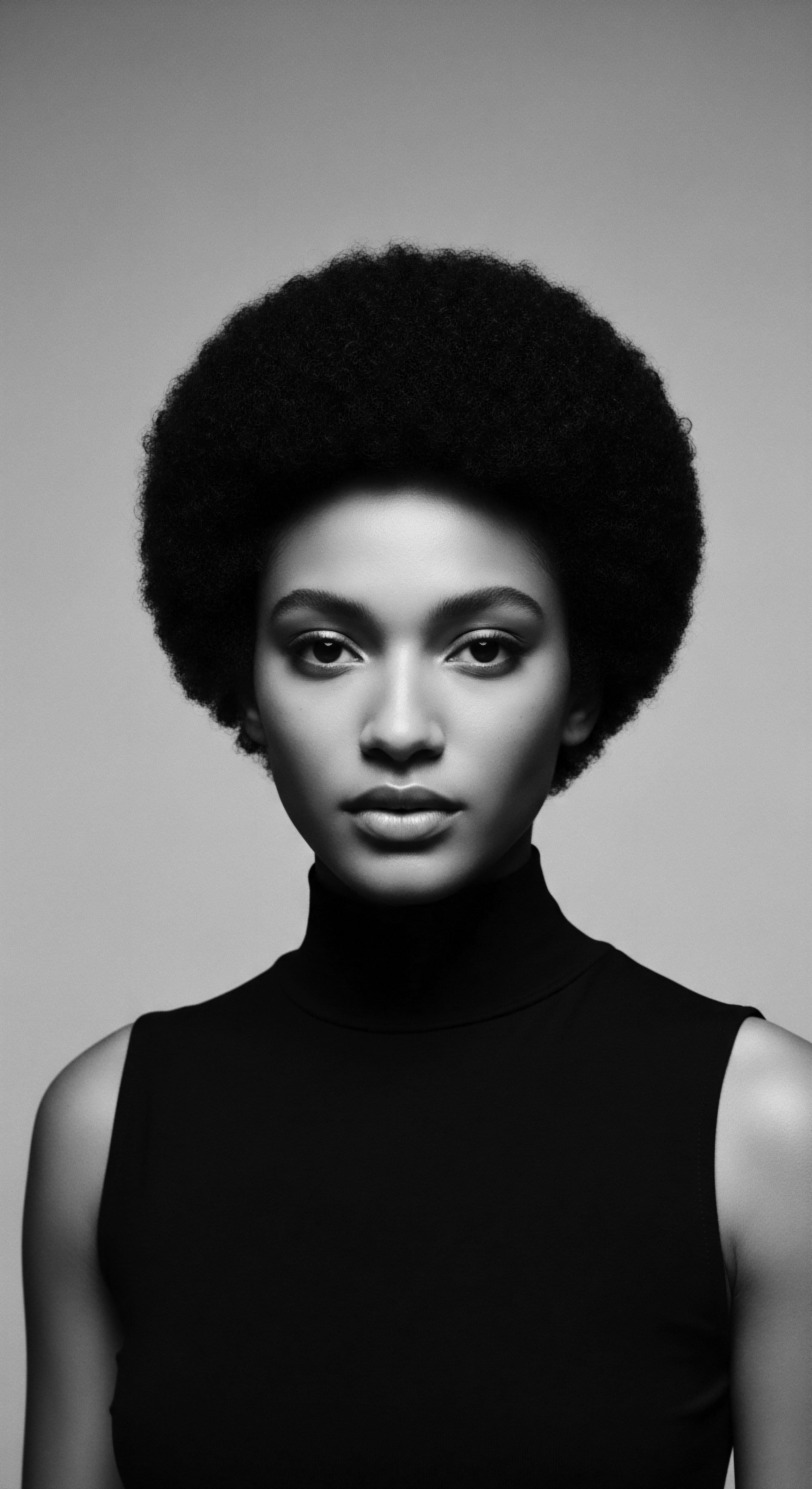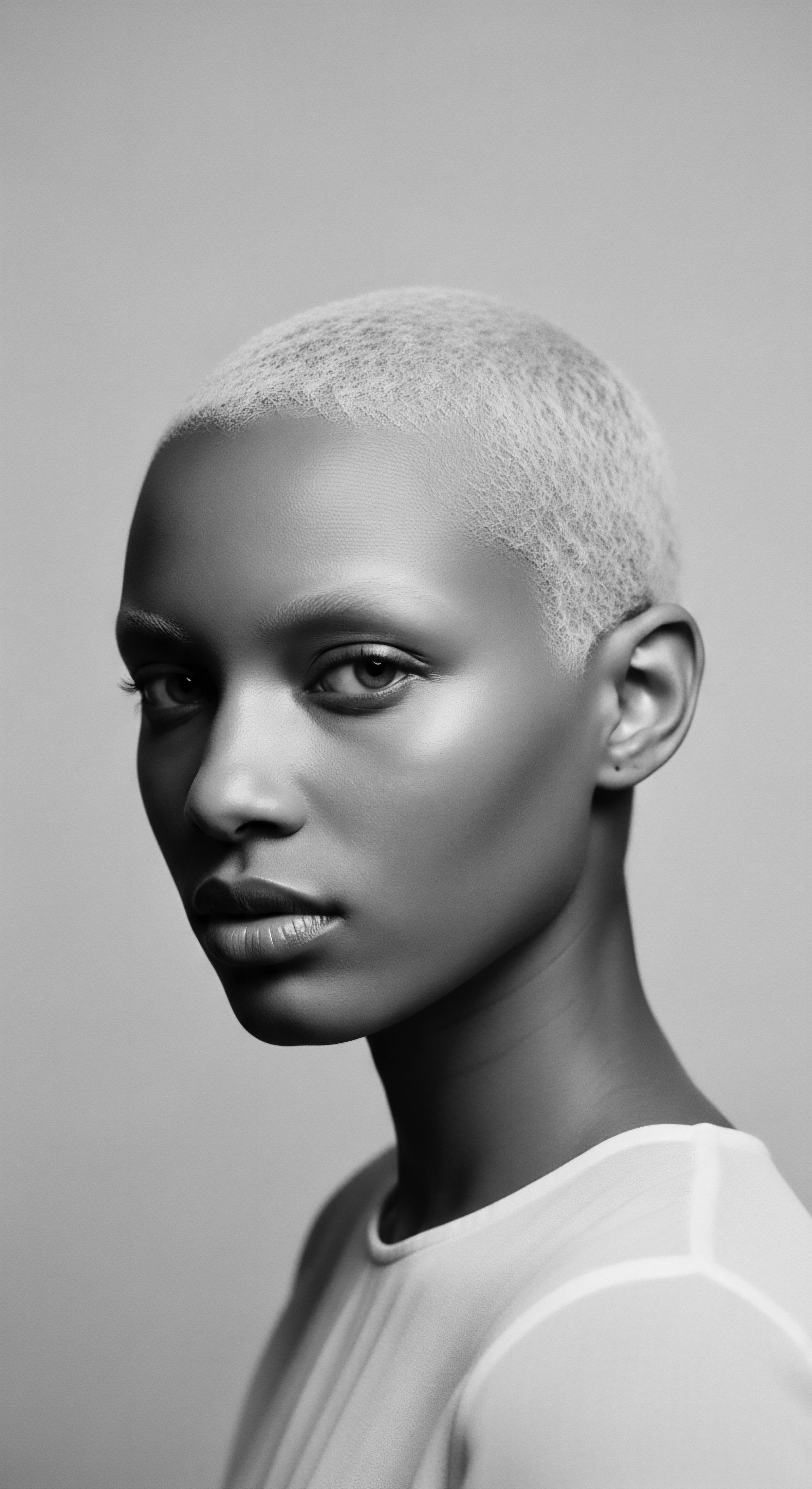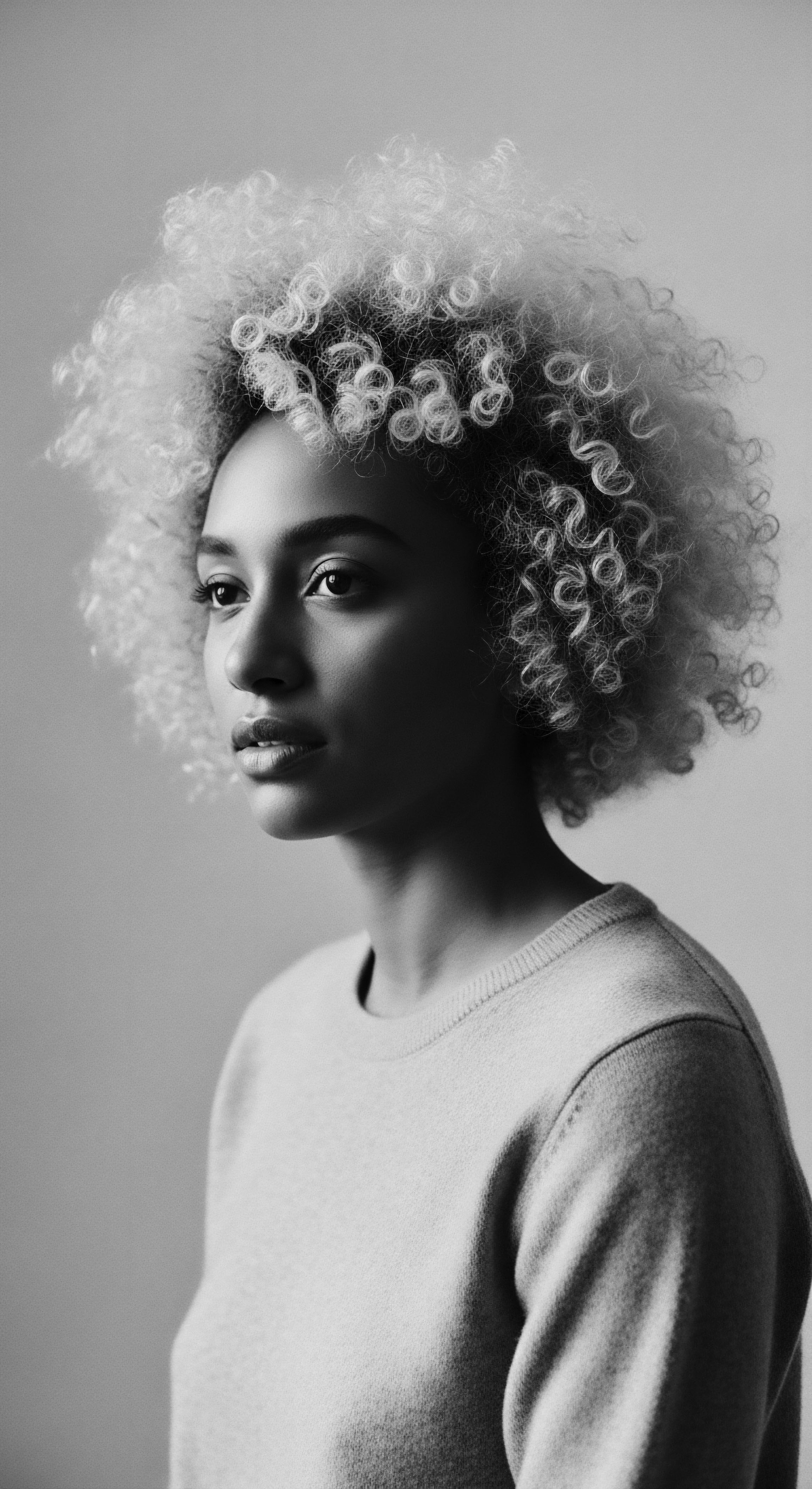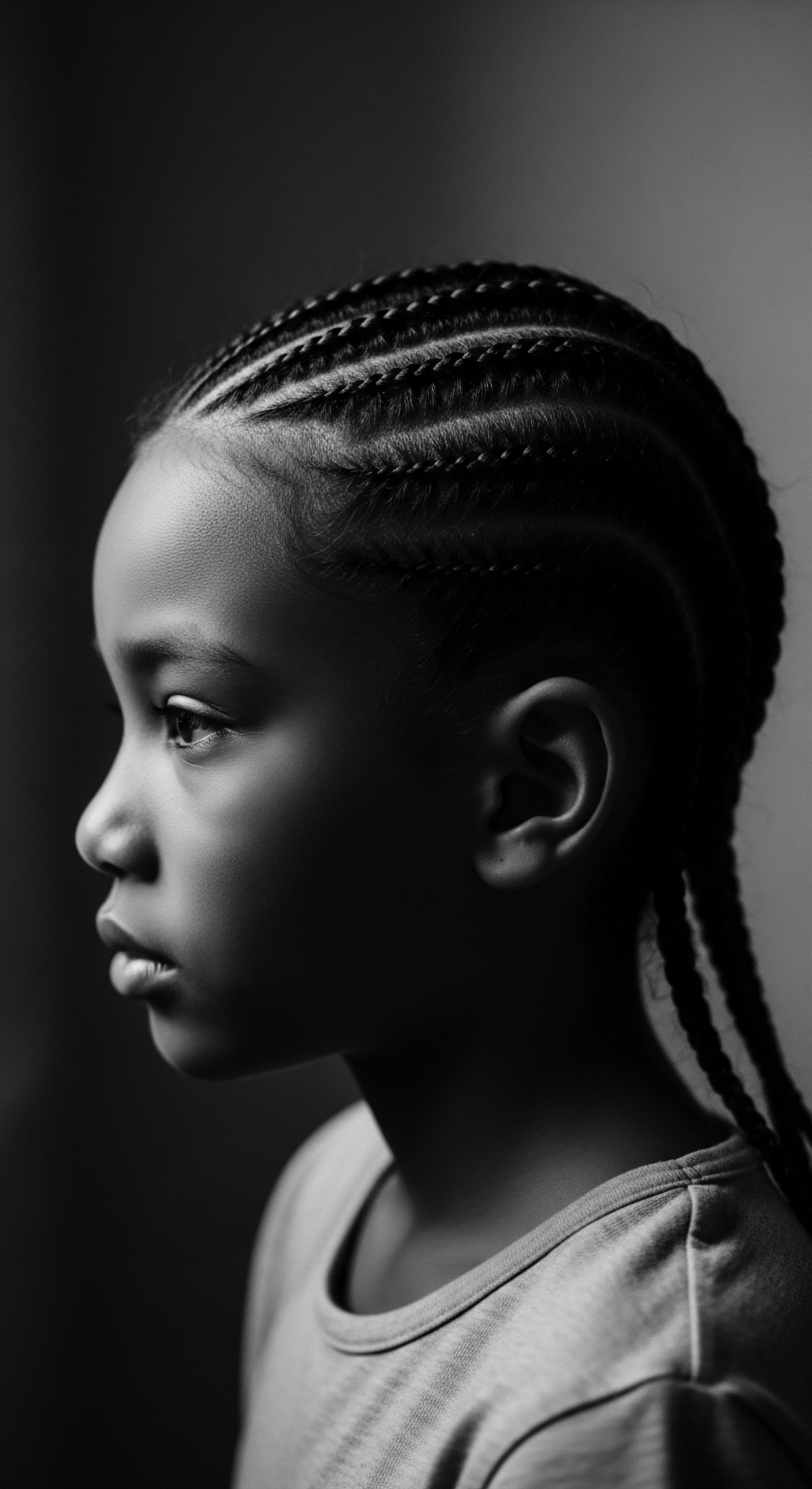
Roots
Consider for a moment the profound stillness of the night, a canvas where daily struggles recede, and the subtle rhythms of life take hold. For those of us with textured hair, particularly within Black and mixed-race communities, the hours of sleep have never been merely about rest. They have always also presented a quiet challenge ❉ how to safeguard the precious strands, to preserve their coiled majesty from the friction and stress that sleep inevitably brings. This need for nocturnal preservation, deeply interwoven with ancestral wisdom, has given rise to practices and items that speak not only of hair care but of a profound reverence for identity, resilience, and heritage.
The very structure of textured hair, with its unique helical twists and turns, lends it a captivating strength yet also a delicate vulnerability. Each bend in the strand means a potential point of weakness, a spot where moisture can escape and friction can cause breakage. Understanding this elemental biology, generations past, without the aid of microscopes or molecular diagrams, arrived at solutions rooted in intuitive observation and a deep connection to the natural world. These solutions were not accidental; they were born of necessity and passed down through countless hands, each one a testament to inherited knowledge.

The Sacred Strand’s Vulnerability
The anatomy of textured hair, often characterized by its elliptical shape and varied curl patterns, makes it distinct. These curl patterns, ranging from loose waves to tight coils, determine how light reflects, how moisture is retained, and how prone a strand might be to dryness and breakage. Unlike straighter hair types, textured hair’s cuticle layers, which act as protective scales, are often more raised, making it easier for moisture to escape.
This inherent characteristic means that without proper care, especially overnight, these strands can lose hydration quickly, leading to brittleness and tangles. The need to preserve this delicate balance, to keep the hair hydrated and the cuticle smooth, shaped the traditions of night protection.
The nocturnal preservation of textured hair echoes ancient wisdom, safeguarding strands from the day’s friction and maintaining their inherent moisture.
Early ancestral practices understood this intrinsic dryness. They recognized that the natural oils produced by the scalp struggled to travel down the length of the coily strands. This observation, though unarticulated in scientific terms, led to the development of methods aimed at sealing in moisture and reducing external stressors.
The desire to maintain vibrant, healthy hair, not solely for aesthetic reasons, but for its deep social and spiritual significance, propelled communities to devise ingenious protective measures for the sleeping hours. Hair has always held a special place in African cultures, symbolizing identity, social status, and spiritual connection.

What Did Our Ancestors Understand About Hair Needs?
Our forebears possessed a nuanced understanding of hair’s needs, often derived from observation of nature and the properties of local plants and materials. They perceived that sleeping on rough surfaces could snag delicate hair, leading to breakage and tangles. They also recognized that exposure to the elements, even indoors, could dry out hair.
This intuitive grasp of hair’s fragility led them to seek solutions that minimized friction and maximized moisture retention. The simple act of covering the hair at night became a practical application of this knowledge, a way to nurture the strands as they rested.
In many African societies, the act of hair care was a communal, intergenerational practice. It was a time for storytelling, for sharing wisdom, and for reinforcing familial bonds (Sands, 2011). The nighttime rituals, whether for braiding children’s hair or preparing an elder’s coiffure, were not solitary acts but often involved the tender hands of mothers, aunts, and grandmothers, who instinctively knew how to tend to these sacred crowns. This communal aspect further cemented the importance and efficacy of these protective measures.

Ritual
The transition from day to night, from active life to restorative slumber, has long been punctuated by specific rituals for textured hair. These practices were not merely functional; they were imbued with cultural meaning, a testament to the ingenuity and resourcefulness of communities across the African diaspora. The materials and methods employed were often simple, yet profoundly effective, speaking volumes about the care and reverence held for textured hair.

Wrappings and Coverings The Ancient Protectors
At the heart of nocturnal hair protection were various forms of coverings. These ranged from simple pieces of fabric to intricately tied wraps, each chosen for its ability to shield the hair. The primary purpose was to create a barrier between the hair and abrasive sleeping surfaces, typically made of rougher fibers like cotton, which can absorb moisture and create friction, leading to tangles and breakage. Silk and satin, known for their smooth surfaces, reduce friction and prevent hair tangling and breakage.
Early forms of head coverings, often called Headwraps, Head Ties, Duk, or Doek, have deep roots in African cultures, serving practical and symbolic purposes for centuries. These cloths were not limited to nighttime wear; they were also prominent during the day, signifying social status, marital status, or even religious devotion. However, for nighttime, their role shifted specifically to safeguarding the hair.
- Fibers of Choice ❉ While luxurious materials like silk and satin are widely recognized today for their hair-protective properties, historical accounts suggest a broader range of natural fibers were utilized. Fabrics derived from locally available plants or animal fibers, chosen for their relative smoothness or ability to be woven into a less abrasive texture, were certainly used. Over time, as trade routes expanded, finer materials like Madras cloth from India became accessible in regions such as the Caribbean, offering additional options for head coverings.
- Headwraps and Scarves ❉ These were fundamental. A simple piece of cloth, carefully wrapped around the head, could secure loose hair, braids, or twists, preventing them from rubbing against rough surfaces. The wrapping techniques themselves could be simple or complex, creating a compact ‘package’ for the hair that retained its style and moisture.
- Bonnets ❉ While the term “bonnet” might conjure images of European fashion, historical records show that bonnets, particularly simple fabric caps, became practical tools for Black women to sustain and protect their hair’s texture. These were adapted to suit the needs of textured hair, providing a contained space for hair overnight.
The method of wrapping was as significant as the material itself. Hair might be gathered at the crown, loosely twisted, or carefully braided before being covered. This preparation minimized stress on the strands, allowing them to rest in a protected state.

Are Headrests for Hair Protection?
Beyond direct coverings, some ancestral communities employed Headrests, often referred to as neckrests or pillows, designed to elevate the head and preserve intricate hairstyles during sleep. These items, found across various African cultures and even in ancient Egyptian and Nubian grave furniture, demonstrate an ancient understanding of preventing hair deformation and breakage by minimizing contact with flat surfaces.
Consider the meticulous artistry involved in certain traditional African hairstyles, which could take days to create and were meant to last for extended periods. To disrupt such a coiffure during sleep would be counterproductive to the effort and cultural significance invested. Headrests, often carved from wood or other natural materials, provided a solution.
They allowed the head to be supported with minimal disturbance to the hair, ensuring the style remained intact and protected from crushing or friction. This ingenious tool speaks to a deep respect for hair as an art form and a marker of identity.

Traditional Oils and Butters Sealing in the Night’s Moisture
Nighttime protection was not solely about physical barriers. The application of natural oils and butters was a complementary practice, working in tandem with protective coverings. These emollients played a vital role in sealing moisture into the hair shaft, providing a lubricated surface that further reduced friction, even under a covering.
Many traditional African hair care practices emphasized the use of natural oils. Shea butter, sourced from the shea tree, was (and remains) a highly valued ingredient across West Africa, known for its moisturizing and emollient properties. Other oils, such as coconut oil, argan oil, and castor oil, also find historical precedent in various regional hair care traditions. These were applied to the hair and scalp before wrapping, creating a protective layer that helped maintain the hair’s hydration levels throughout the night, counteracting the natural tendency of textured hair to lose moisture.
| Traditional Item Headwraps / Scarves |
| Primary Material Various natural fibers (cotton, plant fibers), later Madras cloth, silk |
| Function in Heritage Care Minimized friction, retained moisture, secured hairstyles, communicated identity. |
| Traditional Item Bonnets |
| Primary Material Fabric (often simple, later adapted with finer materials) |
| Function in Heritage Care Contained hair, reduced tangles, shielded from rough surfaces. |
| Traditional Item Headrests / Neckrests |
| Primary Material Carved wood, other natural materials |
| Function in Heritage Care Elevated head to preserve elaborate hairstyles, prevented crushing and friction. |
| Traditional Item Natural Oils and Butters |
| Primary Material Shea butter, coconut oil, castor oil, plant extracts |
| Function in Heritage Care Sealed in moisture, added lubrication, nourished scalp and hair. |
| Traditional Item These traditional items illustrate a holistic, deeply ingrained approach to textured hair care, prioritizing both physical preservation and cultural expression. |
The thoughtful combination of these items and practices speaks to a practical science born of generations of lived experience. It is a system that recognized the inherent qualities of textured hair and developed effective, accessible solutions long before modern chemistry offered synthetic alternatives.

Relay
The legacy of traditional items for nighttime hair protection extends far beyond their immediate practical use. They represent a cultural relay, transmitting ancestral wisdom, resilience, and identity across generations. This section explores the deeper socio-cultural implications of these practices, connecting historical precedents with contemporary understandings, and illuminating the profound science inherent in these age-old customs.

How Does Heritage Shape Hair Science?
The science of textured hair, as understood today, often validates the very practices that arose from ancestral wisdom. Modern trichology confirms that minimizing friction, retaining moisture, and protecting delicate strands are indeed crucial for maintaining the health and length of curly and coily hair. The rough surfaces of cotton pillowcases can absorb hair’s natural oils and create microscopic tears on the cuticle, leading to dryness, frizz, and breakage. This understanding, though articulated through a different lexicon, is the same principle that led ancestral communities to wrap their hair in smoother cloths or use headrests.
Consider the particular challenges posed by low-porosity hair, common in many textured hair types, where the cuticle layers are tightly closed, making it difficult for moisture to penetrate. Scientific studies suggest that heat, like that gently retained by a well-wrapped head, can assist in opening these cuticles, allowing beneficial oils and treatments to be absorbed more effectively. This biological reality aligns with the practice of applying oils or water-based products before wrapping the hair at night, creating a micro-environment that encourages deep hydration and protection. The synergy between scientific understanding and traditional methods is clear; one illuminates the other.
The enduring practice of nighttime hair protection for textured hair stands as a testament to ancestral ingenuity, a historical echo of science applied through intuition.
The use of silk and satin for head coverings, while sometimes associated with luxury today, has a demonstrable scientific basis for hair health. Silk’s smooth fibers reduce friction, preventing tangles, knots, and breakage, particularly for delicate textured strands. Unlike cotton, which can absorb moisture from the hair, silk allows hair to retain its natural oils, maintaining hydration throughout the night. This property directly combats the natural tendency of textured hair to be dry, contributing significantly to its overall strength and resilience.

Cultural Significance Beyond Practicality What Deeper Meanings Do These Items Carry?
Beyond their physical benefits, these traditional items protected more than just hair; they protected dignity, identity, and cultural continuity. During periods of enslavement and oppression, particularly in the Americas, head coverings took on layers of complex meaning. Laws like the Tignon Laws of 1786 in colonial Louisiana mandated that Creole women of color cover their hair, an attempt to strip them of their beauty and assert social control. Yet, these women transformed symbols of subjugation into acts of resistance, adorning their mandated headwraps with elaborate styles, luxurious fabrics, and personal flair, turning them into statements of defiance and pride.
This historical example underscores how a seemingly simple item became a powerful vessel for cultural expression and resilience in the face of immense adversity. The headwrap became an assertion of Black womanhood, distinguishing wearers and reclaiming self-love.
This phenomenon, where items of necessity became symbols of cultural affirmation, continued through generations. From the late 19th to the early 20th century, as many African American women moved towards straightened hairstyles in an attempt to navigate a society that often marginalized natural hair, the bonnet remained an intimate, personal tool for preserving styled hair at night, even if it was not always seen in public. The private ritual of care, protected by these traditional items, became a space of personal autonomy and continuity with a past that valued hair in its natural state.
Even the act of hair preparation itself, often occurring in communal settings, served as a powerful social glue. “Aunt Tildy” Collins, a formerly enslaved person, recounted how her mother and grandmother would prepare her hair for Sunday school, threading or plaiting it to achieve defined curls, a ritual that speaks to intergenerational knowledge transfer and community building. These moments, often involving the tender handling of hair and the sharing of stories, reinforced family bonds and transmitted care practices from elder to youth.
- Durags and Wave Caps ❉ While bonnets and headwraps are commonly associated with women, men too have traditional items for nocturnal hair protection. The Durag and Wave Cap, for instance, are widely used in Black communities to maintain waves and short styles, keeping hair compressed and protected. These items, particularly the durag, have evolved from a practical utility to a potent symbol of Black male identity and style.
- African Threading ❉ This ancient technique, where thread or yarn is tightly wrapped around sections of damp hair overnight, not only stretches the hair but also reduces shrinkage, preparing it for styling the next day. This method, passed down through generations, highlights a deep understanding of hair’s plasticity and how tension can be safely applied to achieve desired results while protecting the hair from external elements during sleep.

Reflection
As the moon traces its path across the night sky, casting a gentle glow, we are reminded of the enduring whispers of ancestral wisdom. The traditional items that protected textured hair at night were never just simple cloths or carved wood; they were artifacts of ingenuity, resilience, and a profound reverence for identity. These practices, rooted in the very soul of a strand, speak to a legacy of care that transcends centuries, reminding us that true beauty springs from a deep understanding of ourselves and our heritage.
The coiled and coily strands of textured hair carry within them the echoes of history, a testament to generations who navigated adversity while holding fast to their self-worth. The bonnets, headwraps, and headrests, born of necessity and transformed by creativity, stand as silent guardians of this story. They whisper of mothers braiding by lamplight, of communities sharing knowledge, and of individuals finding dignity in the face of societal pressures.
In a world that often seeks to standardize and homogenize, the continued practice of honoring textured hair, particularly through nocturnal care, serves as a powerful anchor to our collective past. It is a living archive, where the smooth glide of silk, the snug fit of a bonnet, or the careful twist of a scarf connect us directly to those who came before. This heritage, vibrant and alive, guides us not only in preserving our hair but in understanding the deeper currents of self-acceptance and cultural pride. Every strand, protected through the night, carries forward a luminous history, ready to greet the dawn.

References
- Afriklens. (2024). Natural African Haircare ❉ Celebrating the Afro and Braids. Afriklens.
- Allen, M. (2021). Braids, Plaits, Locs ❉ The History of Black Protective Hairstyles. Royaltee Magazine.
- Tihara Smith. (2025). Caribbean Madras Fabric ❉ Threads That Connect Continents. Tihara Smith.
- Nationalclothing.org. (2018). A short history of African headwrap. Nationalclothing.org.
- Cee Cee’s Closet NYC. (2021). The History of Bonnets. Cee Cee’s Closet NYC.
- JD Institute of Fashion Technology. (2021). HEADWRAPS ❉ HISTORY AND EVOLUTION. JD Institute of Fashion Technology.
- Obé Headwear. (2024). Significance of headwraps | Hair care. Obé Headwear.
- Roseborough, I. E. & McMichael, A. J. (n.d.). Hair Care Practices in African-American Patients.
- Helix Hair Labs. (2023). THE HISTORY OF THE HAIR BONNET. Helix Hair Labs.
- The Silk Collection. (2023). Benefits of Silk Hair Wrap for Sleeping | Silk Bonnet. The Silk Collection.
- Soft Rows. (2024). A cultural exploration of head coverings- turning simple pieces of fabric into crowns of protection and self-expression. Soft Rows.
- Afrostreet. (2025). The Cultural Significance of Headwraps & How to Wear Them ❉ Embracing Heritage and Style. Afrostreet.
- Pan-African. (2021). Effective Afro Hair Care Routines. Pan-African.
- Sinosilk. (2024). A Guide to Different Head Wraps. Sinosilk.
- Jaycee Naturals. (2025). Low-Porosity Hair Care ❉ The Truth About What Actually Works. Jaycee Naturals.
- Okoro, N. (2023). Material Intimacies and Black Hair Practice ❉ Touch, Texture, Resistance.
- Orticolario. (n.d.). Press Releases. Orticolario.
- Sands, C. (2011). Hair in African Art and Culture.
